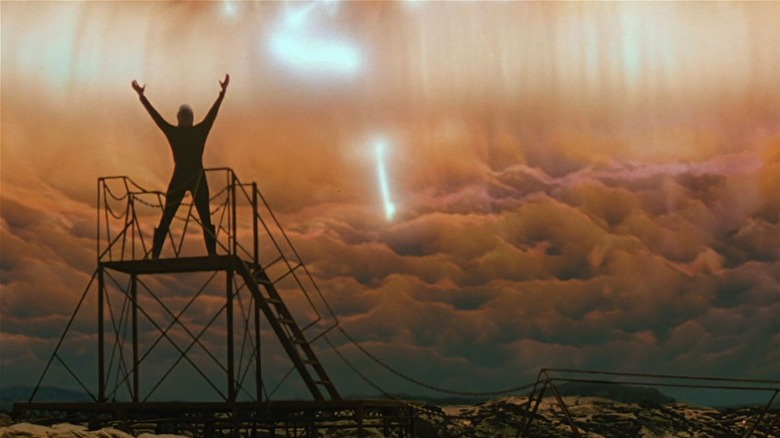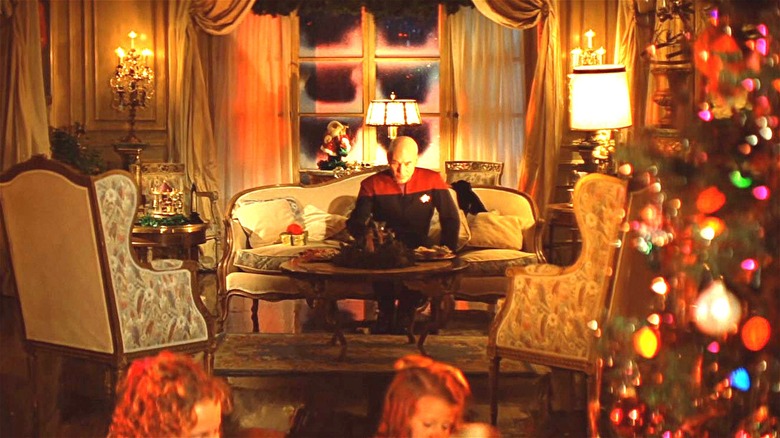Star Trek: What Is The Nexus?
In the real world, space and time tend to follow the laws of physics. But in the world of "Star Trek," this is not always the case — a fact that caused something of a mess for two generations of Starfleet captains in the "Star Trek: The Original Series" and "Star Trek: The Next Generation" crossover film "Star Trek: Generations."
The film, which brings 23rd-century Captain James T. Kirk (William Shatner) together with 24th-century Captain Jean-Luc Picard (Patrick Stewart) before killing the former (in a death Shatner would love to get a do-over on), finds both in a temporal energy ribbon that looks and feels a lot like a version of Heaven. Inside the Nexus, time and space become irrelevant as one's very thoughts shape the nature of reality.
For those trapped inside of this Nexus, this can mean bringing back long-lost loved ones or creating an alternate timeline for their lives. The allure is so strong that even Kirk doesn't want to leave it, telling Picard, "This Nexus of yours is very clever. I can start all over again — do things right from day one." For El-Aurian scientist Tolian Soran (Malcolm McDowell), it's even worth destroying two stars to divert the ribbon toward him in the hope of reuniting with his family, who were killed in a Borg attack. In Mark A. Altman's "The Fifty-Year Mission: The Complete, Uncensored, and Unauthorized Oral History of Star Trek: The Next 25 Years from The Next Generation to J. J. Abrams," McDowell described the Nexus as "something that affects you like a drug [...] not unlike a hallucinogen into which you can sink and be happy within the confines of. You really need to be able to find the strength to deny it." (p. 322)
The Nexus is about cheating nature
The fact that all life ends is hard enough for humans to grasp. For a species as long-lived as the El-Aurians like Guinan (Whoopi Goldberg) and Soran, the prospect of outliving their loved ones could mean outliving them by centuries. As Soran and Kirk would discover, the Nexus represented a chance to circumvent that loss, effectively cheating the very nature of time by simply imagining the world they wanted to live in. To Soran, the Nexus was a world where his family was alive and well. Kirk found himself in the bucolic setting of his uncle's mountain cabin and farm on a specific day in 2282, just before meeting the love of his life, Antonia (Lynn Salvatori) — a woman he had abandoned for Starfleet two years later.
But as Kirk would discover, these versions of their loved ones were far from real. Instead, the Nexus created fictions imagined by their minds rather than a real opportunity to start over — something made evident by Picard's Nexus vision. Like Soran, who serves as a foil to Picard's own grief in this movie, the Enterprise-D captain had watched his entire family die tragically in one of the darkest moments in Picard's life when his brother, sister-in-law, and young nephew René were killed in a house fire. Just as it had brought back ghosts from Kirk's and Soran's past, the Nexus resurrected René.
But it also created a fictional family in his wife Elise (Kim Braden) and five charming Picard children, a manifestation of the captain's secret longing for family, in the midst of a Christmas celebration with a picture-perfect Victorian aesthetic. As the script reads, "He can't help but be moved and drawn in by the blanket of love he finds himself underneath."
A transporter fluke left Guinan's echo
Although the world inside of the Nexus seems to be fictional, it also appears to exist in a way that is beyond human understanding, particularly for El-Aurians, who possess limited telepathic traits, as an earlier-timeline version of Guinan demonstrates in "Star Trek: Picard." Like Soran, Guinan was one of the El-Aurian refugees in the process of being evacuated to Earth when their two ships had become trapped in a gravimetric field connected to the Nexus, causing the passengers to get caught up in the energy ribbon. According to Montgomery Scott (James Doohan), the refugees appeared to be "phasing in and out of our spacetime continuum" while caught in "some sort of temporal flux." Describing the experience later, Guinan would tell Picard, "It was like being inside joy. As if joy was a real thing that I could wrap around myself. I've never been so content."
While trapped in the Nexus, Picard meets the older version of Guinan he had come to know aboard the Enterprise-D, who tells him it is really her — but not exactly her. "Think of me as an 'echo' of the person you know [...] somehow everyone left a part of themselves behind." Screenplay co-writer Ronald D. Moore would later clarify this in a 1997 AOL chat, explaining that the echo had to do with their presence in the Nexus as they were beamed out.
According to Moore, the El-Aurians were in "some kind of transitional phase" as their ships exploded. While the Enterprise-B had brought back their bodies, the process, rather than their telepathy alone, had left the refugees somehow connected to the Nexus. "The momentary sensation of being in the Nexus leaves both Guinan and Soren with an almost overpowering desire to return," Moore added.
Some fans think the Nexus has a Q connection
Although the origin and nature of the Nexus are never explained in the "Star Trek" television and film universe, some fans have come up with an interesting and surprisingly plausible fan theory connecting the phenomenon to the Q species. As timeless, godlike beings, members of the Q Continuum are constantly interfering in the affairs of other beings, with one Q (John de Lancie) taking a particular interest in Picard through the years. They possess nigh-omnipotence with the apparent ability to manipulate the very fabric of spacetime with little more than a mere snap of their fingers.
One Reddit fan theory posited that it's actually the Nexus that is responsible for the Q's unique abilities, suggesting that the energy ribbon itself serves as the entrance to the Q homeworld — another place seemingly outside of spacetime where thought and reality seem to blur. The theory suggests that the Q were once mortals who became trapped in Nexus, where they spent millions of years evolving inside a realm where reality is shaped by thought.
A Q-Nexus connection is also supported in the novel "Star Trek: The Next Generation: Q Continuum." Although "Star Trek" novels are not necessarily canon, Den of Geek's deep dive on the subject concluded that they often inform canon, citing several novels and comics that did just that. And, according to the "Q Continuum" trilogy, it was Q himself who created the Nexus as a result of youthful recklessness.



